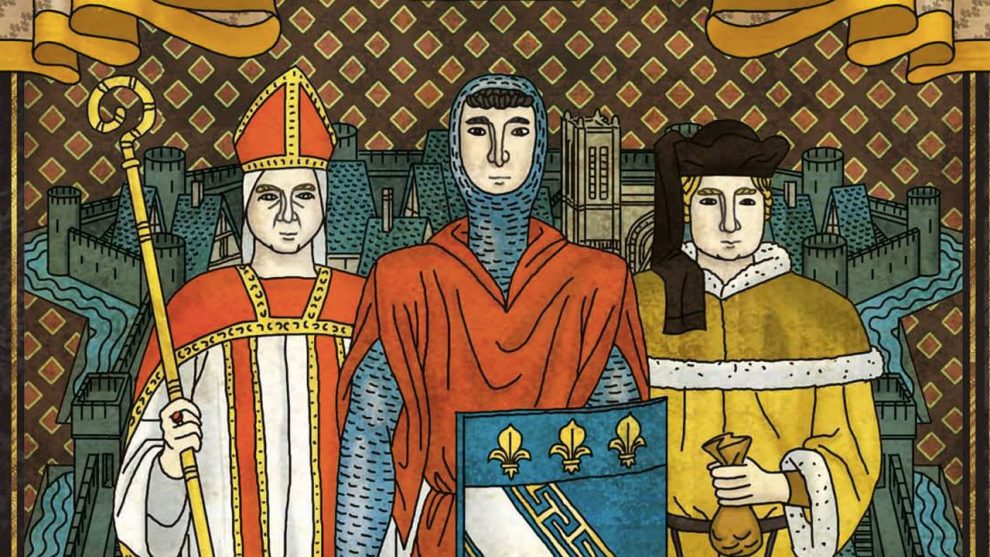As of late, dice have been all the rage in euro style games. Castles of Burgundy (2011) gives you dice corresponding to different bins of actions. If you don’t like a roll of your dice, you can trade it for workers that can be used to modify future die rolls. Roll for the Galaxy (2014) comes with a plethora of different dice, each of which has the same basic actions on them. These dice have different distributions of the actions and the game allows you to use one die of any type to do any particular action. In The Voyages of Marco Polo (2015) if you don’t roll well, you get free resources as a compensation. Also, any low-valued dice are equally valuable for some actions and may be used to block your opponents. In Grand Austria Hotel (2015), players draft dice from a collective pool and take actions based on the number of dice available from that number.
Published in 2010, Troyes (pronounced “Tw-ah” like you took a sip of a refreshing beverage) is the hipster older brother (grandpa?) of these innovative dice games from the last few years. I’m here to tell you that, even though Troyes is one of the first, it’s the best.
In Troyes you’re managing a portion of the population of the city of Troyes in the Champagne region of France. While building your civilization, you’ll be sending tradesmen to buildings, battling attacking enemies, and taking on events; all while combating your opponents for the best spots on the board. Even though this is a euro game, dice are used to accomplish all of the mechanisms in Troyes.

Components
In the box there are four different colors of dice, a series of cards, a game board, cardboard punch-out pieces for money and victory points, and player pieces. Honestly, the pieces aren’t remarkable, but they’re perfectly usable. The dice are slightly smaller than average, mostly to have them fit on the player area in the board.
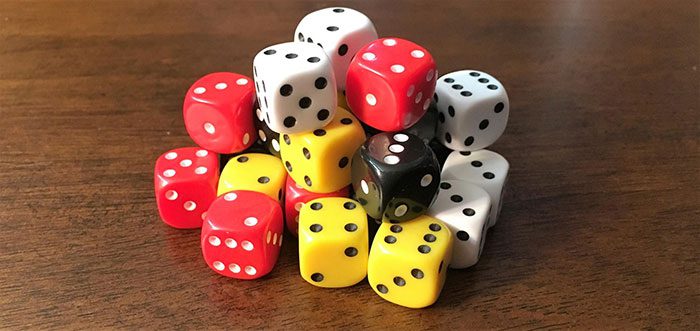
The artwork on the game board and cards is consistent and fairly attractive. The artist, Alexandre Roche, did an impressive job of capturing the ramparts and bustle of the city of Troyes using muted tones that don’t detract from the overall gameplay.

The pieces are a little thin but, in general, totally usable. For perspective, these pieces are slightly thinner than the hexes in Castles of Burgundy.
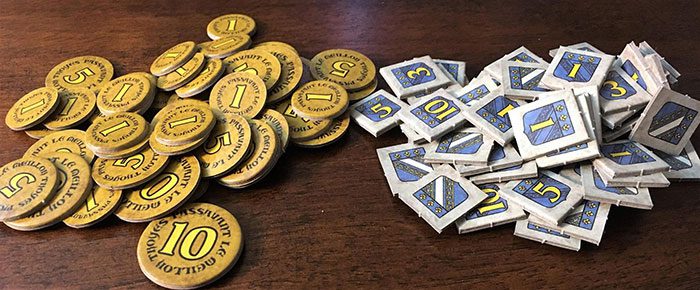
Overall the components are good but in the spirit of many euros they’re nothing to write home about.
Gameplay
In Troyes players use the red, yellow, and white dice to perform a variety of different actions. The first step in the game is to determine your starting dice. Players draft positions in three buildings: the Palace, Bishopric, and City Hall. For each worker on the Palace the player receives a red die, for each worker on the Bishopric the player receives a white die, and for each worker on the City Hall the player receives a yellow die.

Each round players get an income of ten coins and pay the salary for their dice, two coins per red die and one coin per white die. Players then roll their dice, which will be used for a variety of actions. Each turn, two event cards are revealed which may send raiders, represented by black dice, to the city. These events may also affect other aspects of the game such as removing players’ workers from the buildings.

After the events are revealed, the black dice are rolled and, starting with the first player, each person has to defeat one or more dice, using their own dice, until all of the black dice have been eliminated for that round. For each black die you defeat you gain one influence which I’ll talk about a little later. The event cards stay in play and can be combatted on your turn (more about that a little later).
After the black dice have been countered, players then proceed to take their actions. A player’s turn consists of sending groups of up to three dice, typically of the same color, to do a particular action. At any point you can buy dice from other players’ spaces on the board (shown below) by paying the money to them. The cost of each die depends on how many dice you’re using for the action. When buying dice, each die you purchase costs two times the total number of dice you’re using for the action. So, if you’re using one die it costs two money to purchase it from another player. If you’re using two dice, each die you purchase from another player costs four money, etc. Before you perform an action you can use the influence points I mentioned earlier to re-roll your dice. If you pay one point of influence you can re-roll any one of your dice or if you pay four influence points you can flip dice to their opposite side (i.e 1 to 6, 2 to 5, etc).
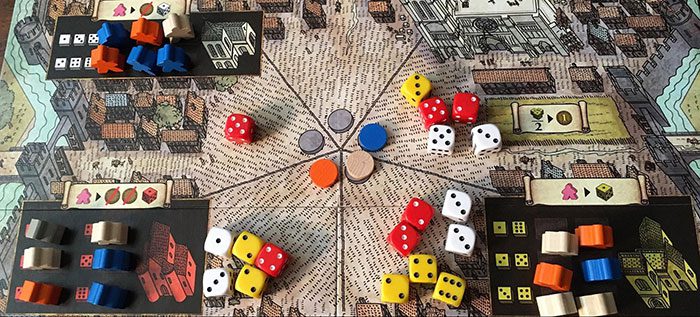
There are several types of actions you can take. The first type of action is to combat the event cards. If you look at the example events, you’ll see that each has a color of dice on it, a number by that die, a series of spaces with flags in them, and two victory point markers in blue. You can use your dice of the color specified on the card to combat the events. For each time you meet the pip requirement, you can place one cube on the card and gain one influence. Once the last space is filled, the player with the most cubes on the card gets the top number of victory points and the player with the second most gets the second number. Ties are broken by the player with the earlier cube on the card.
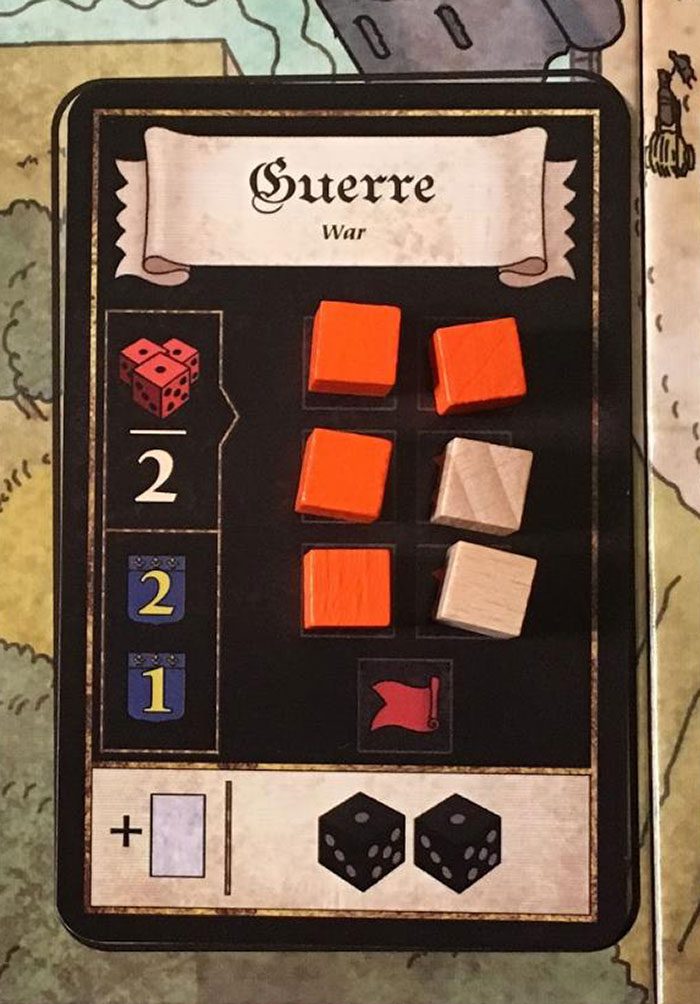
The second type of action you can take is adding workers to buildings. The building locations players selected have one to three dice values associated with them. These dice indicate the number value of the die used to add a worker to that location. For instance, to send a worker to the top space in the yellow building, you would need to spend a 1 or 6 pip yellow die.

The third type of action you can take is building the cathedral. You do this by using one or more white dice to send cubes to the cathedral. For each cube you add to the cathedral, you gain one victory point and one or two influence depending on the value of the dice.

The final type of action you can use is the tradesmen. During each of the first three rounds, a new tradesman of each color (red, white, and yellow) is revealed. Once players have a worker at the tradesman, they can use a group of dice to perform an action. In order to send a worker to a tradesman, the player must pay the cost for the location which is listed on the card. Then you need to either hire a worker or remove one from somewhere else on the board. These actions can gain you money, let you place out cubes on the events, get you additional actions on future turns, score you victory points, and a variety of other actions.

The diplomat, in red, lets a player spend one influence to place a cube on an event card. The player can do that once for every three pips of red dice sent there.
The miller, in yellow, allows the player to receive two coins for the number of workers they have in the palace or the city hall. The player can do this once for every four pips of yellow dice sent there.
The tithe, in white, allows a player to place one cube onto the card for every four pips of white dice sent there. These cubes can be used later to use one white die from each other player at no cost.
The game ends after the fourth round is completed. At the end of the game, players score points based on victory point tokens they have accrued throughout the game, points for the spots on the tradesmen, negative points for each row of the cathedral they do not have a cube in, points based on events they have cubes on, and finally, points for hidden bonus cards. The hidden bonus cards score bonuses based on all players’ bonus cards, not just their own. These bonuses range from the number of workers you have in buildings, to the number of cubes you have in the cathedral, to the number of event cards you’ve collected.
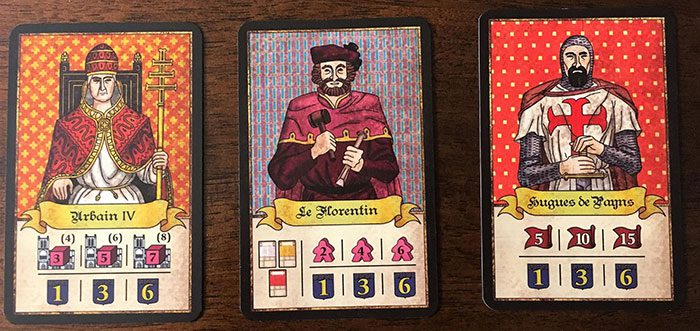
Urbain scores 1/3/6 victory points for having 3/5/7 cubes in the cathedral. Le Florentin scores 1/3/6 victory points for having 2/4/6 workers at tradesmen. Hugues de Payns scores 1/3/6 victory points for having 5/10/15 influence.
So you’re saying there’s an expansion?
The Ladies of Troyes is one of the best expansions I’ve ever played. It was an immediate buy for me for several reasons. The Ladies comes with several modules that can be combined together with the base game. The simplest module is new bonus, location, and event cards and, for me, those got mixed into the base set without question. The second module is the purple dice, which is easily the best part of the expansion.

Each player gets a purple die, which they roll with the rest of their dice. This purple die can act as a die of any color and cannot be bought by other players. This is another great opportunity for mitigation of randomness since these dice can’t be bought and they can act as any color. The third module from the ladies is the ramparts, where players have a guard they move around to gain a variety of bonus actions.
Overall, the Ladies expansion is a fantastic addition to the base game. It probably isn’t necessary early on since a lot of the additions broadly expand the action space, but it is a great addition for experienced players. As a side note, the purple dice module is by far the best module from the expansion. If you want a taste of this module before you buy the full expansion, just snag a few dice from another game, download the rules, and try it out yourself.
What I liked about the game
Troyes is a fantastic game, there are no two ways about it. One of the most exciting aspects of the game, for me, are the dice. As a primarily euro gamer, seeing a pile of dice is typically something I run away from. But at the same time, there’s something so tactile and rewarding about holding a fistful of dice and chucking them. Troyes gives you the tactility of holding and rolling dice and the rush of counting up your pips and seeing how you did. Spending influence to flip over or re-roll dice, using your dice to add workers to buildings, and purchasing dice from other players all give you an opportunity to use your dice even if they may not be quite what you want.
Another one of my favorite aspects of the game is that each player has a secret goal that everyone scores. This adds in a deduction element of trying to figure out what bonuses your opponents have. This simple element adds a layer of depth that you can completely ignore if you want, or you can obsess over.

In many euro games, player interaction is limited to blocking off a worker placement space or taking a tile another player wanted. The player interaction in Troyes is much more nuanced than many euros; the interaction is still challenging but not overly mean or crippling. There are two main forms of interaction in Troyes: buying dice from other players and placing your workers into buildings; both of which are brilliantly done. First, the person you buy dice from gets the resources to buy dice from other players or to reload for the next round. The second form of player interaction, taking worker spaces in the buildings is slightly more direct. I didn’t mention this above, but as you place a new worker into a building, you bump someone else’s worker out. This interaction is a little more imposing than paying someone for dice.
One of the most interesting aspects of Troyes is how it scales at different player counts. Playing a two player game (I have yet to play solo) feels broad with a wide variety of options and depths of turns you can take. On the other hand, playing with four is incredibly tight. You start out the game with fewer dice and your turns are more precise. Each die becomes more valuable and the anxiety of each decision ratchets up. Both ends of the spectrum are uniquely positive experiences and I can’t say I prefer one over the other.
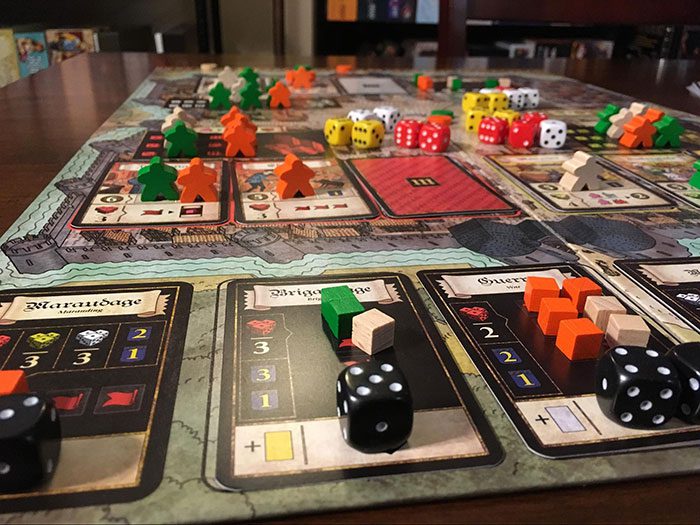
What I don’t like about the game
My biggest complaint about the game is one simple rule: you can’t re-roll dice that you purchase from other players. This issue makes players purchasing high-valued dice from you before you get a chance to use them overpowered. There isn’t a simple way to integrate this rule into the game since you need to commit to using dice for an action.
Troyes is a challenging game to play optimally. I have yet to finish a game where I didn’t feel like I made a sub-par play at some point. The variety of mechanisms in the game makes it easy to miss opportunities and that can be incredibly frustrating or AP inducing.

There can be a run-away leader problem in the game. If a player gets a plurality of dice and money early on, it’s easy for them to pull ahead without giving other players a realistic chance to catch up.
Input Randomness versus Output Randomness
Board games are generally broken into two main categories: games where something random happens and then players act and games where players act and something random happens to decide the outcome of that action. These delineations have been described as input randomness and output randomness by other members of the board game community, so they won’t be belabored here. For instance, in Agricola the worker placement spaces are randomly ordered and you make decision based on the random ordering. On the other hand, in Imperial Assault, the result of combat is based on a die roll. Games with input randomness, like Agricola, use the randomness to provide the players of the game with variety in the game and the decision space is often times based on the randomness. Games with output randomness, like Imperial Assault, simulate the randomness in different types of events and the randomness is more tied into the thematics of the game.

Troyes is one of the earliest and best games at input randomness using dice to give the player opportunities to mitigate that randomness. Between buying dice, re-rolling, flipping dice over, and using dice to gain more dice in the future, Troyes lets players overcome poor die rolls in a variety of ways. In games like Terra Mystica and Kemet, players have perfect information which means that long-term strategy plays a big role. Troyes, on the other hand, combines tactical decision making with long-term strategy to tackle the randomness while allowing players to develop a point generation engine. This combination makes Troyes an incredibly interesting and ever-changing game.
Final Thoughts
Troyes is delightful, combining dice into a meaty euro game. Lately, dice have made their way into a variety of fantastic euro games: The Castles of Burgundy, Grand Austria Hotel, and Roll for the Galaxy amongst others. Troyes is better than these games. The decision space and variety of mechanisms in the game provide an intersection of tactical brilliance and long-term depth that none of these other games provide.
No two games of Troyes that you play will feel the same. With the variety of cards in the base game, you’ll have plenty to do and never feel like you’re at a loss for variability. Beyond that, the expansion adds even more variety to the game along with an interesting breadth and depth of decision. Some modules add more to the base game play and others add new aspects to the game.

My favorite element of the game is the hidden end game goals. Each goal defines a different type of strategy that you can follow and which can radically alter the course of your game play. Since you still score all of the other players’ end of game bonuses, there’s also the added element of deciphering what scoring bonuses the other players have. This is an exceptionally cool opportunity for subtle interaction in the game.
Still not convinced Troyes is for you? Check it out on www.boardgamearena.com. You can play the base game there and cut your teeth learning the ins and outs of the game without having to purchase it. Be wary though. Troyes tends to go out of print and not be available for years.
I highly recommend Troyes to anyone who enjoys heavier euro style games. I hope to have it in heavy rotation for the foreseeable future.
What do you think about Troyes? Give us your opinions about what you like and/or dislike about the game in the comments below!


